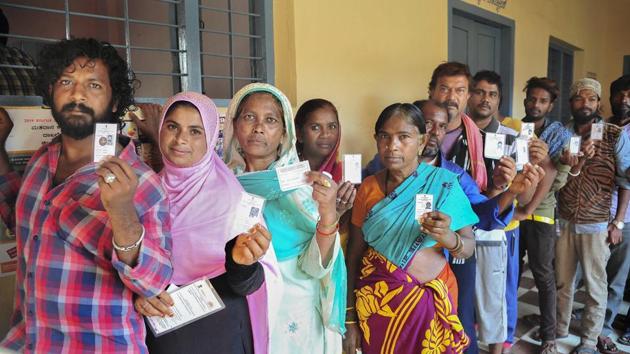Karnataka records highest ever turnout of 68.62% in Lok Sabha polls
Karnataka notched up its highest ever turnout of 68.62% in the LoK Sabha election for its 28 seats which were held over two phases on April 18 and April 23.
As the curtains came down on a high-stakes battle for the 28 Lok Sabha seats in the state, Karnataka notched up its highest ever turnout of 68.62%. Voting in the state was held over two phases on April 18 and April 23.

The state had seen a pitched battle between the ruling Congress-Janata Dal (Secular) alliance and the Bharatiya Janata Party. The coalition sought to challenge the BJP’s hold in the state, as the saffron party had won more than half the seats in the state in the past three elections.
The turnout represented a 1.42% increase over the figure for 2014, when 67.20% electors exercised their franchise. The previous highest was in 1999, when the state recorded a turnout of 67.58%.
The increase in turnout was, however, not uniform with some constituencies seeing a higher turnout compared than others. And primary among those that saw an increase in turnout was Mandya, where Nikhil Kumar, son of chief minister HD Kumaraswamy, went up against Sumalatha, widow of late film star Kannada film actor Ambareesh, who contested as an independent, although she received the BJP’s overt support.
A pitched battle in the heartland of the Vokkaliga dominated Old Mysuru region saw the constituency ensured that the constituency recorded a nine percent increase in turnout, from 71.47% in 2014 to 80.23% this time around. This was also the highest ever turnout recorded in the constituency, beating the previous best of 77.13% recorded in 1984.
The Janata Dal (Secular) had won the seat in 2014 and in the bye-elections held last year. And both candidates had banked on their respective legacies while campaigning.
Similarly, the Uttara Kannada seat saw a 5.06% increase in turnout from 69.04% in 2014 to 74.10% this time around. In this seat, five-time MP Ananth Kumar Hegde of the BJP faced up against Anand Asnotikar of the JD(S) and Congress combine.
Among the other seats that saw an increase in turnout were Tumakuru and Hassan, where former Prime Minister HD Deve Gowda and another grandson Prajwal Revanna contested. In Tumakuru, the turnout was 4.64% higher at 77.21% against 72.57% turnout in 2014. The turnout in Hassan increased 3.62% from 73.49% in 2014 to 77.11% this time.
Dharwad in the Mumbai-Karnataka region and Shivamogga in the Western Ghats recorded 4% increase in turnout. In Dharwad, where three-time MP Pralhad Joshi of the BJP was up against Congress’s Vinay Kulkarni, who was part of the Lingayat separate religion movement, turnout increased from 65.99% in 2014 to 70.13% this time. In Shivamogga, where BY Raghavendra, son of former chief minister BS Yeddyurappa faced off against Madhu Bangarappa, son of former chief minister S Bangarappa, the turnout grew from 72.36% in 2014 to 76.43% this time.
However, there were decreases in Bengaluru as a whole – Bengaluru North, Central, South and Rural – where on average turnout reduced by around 2%, apart from some seats scattered across the state.
Speaking about the numbers, deputy chief minister G Parameshwara of the Congress said no conclusions could be drawn from the numbers themselves. “The numbers in themselves do not necessarily mean anything. What matters is how the campaign was carried out,” he said. “In Mandya especially, the Congress workers, too, took it up as a challenge to come out in higher numbers and this might have added to the final figure.”
JD(S) state president AH Vishwanath said the higher turnout was not the result of any great mobilisation from parties but rather that it was increased voter awareness. Hence, he said, it was difficult to predict what impact this would have. Regarding Mandya, Vishwanath said he was confident Nikhil would pull through. “The increase in votes is not just an increase for one candidate, it is across the board. Besides, Modi speaking about Sumalatha at a rally in Mysuru ensured that the minority communities came over to our side,” he said.
Former chief minister Jagadish Shettar of the BJP said the reason for the higher turnout was the desire among the people to see Prime Minister Narendra Modi get another term. “Everyone wanted to vote for Modi to become prime minister again and did not want to miss out on this chance,” he said. “In Mandya, it was a high voltage campaign from the beginning and as a result a lot of interest had been generated,” he added.
Political analyst Narendar Pani, faculty at the National Institute of Advanced Studies, said while the turnout itself did not represent a significant increase over the previous election, the story was different when one looked at the constituencies.
“The turnout in Mandya is quite significant, and so too in Hassan and Tumakuru, where it was clearly a vote either for or against the Deve Gowda family. Though one cannot draw definitive conclusions from the numbers it is suggestive of a trend in this region,” Pani said.
In constituencies in the northern parts of the state, the local factors played a larger role than the national ones, he said. “It appears from the data that where there have been significant increases these are down to local factors like the choice of candidate and possible anti-incumbency against the sitting MPs,” he added.






